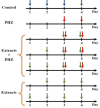The hematopoietic potential of methanolic and aqueous extracts of Portulaca oleracea in a phenylhydrazine model of anemia
- PMID: 36698739
- PMCID: PMC9840774
- DOI: 10.22038/AJP.2022.20965
The hematopoietic potential of methanolic and aqueous extracts of Portulaca oleracea in a phenylhydrazine model of anemia
Abstract
Objective: Portulaca oleracea, commonly known as Purslane, is traditionally used as a sour, diuretic, and cooling herb with hemostatic properties. The present study evaluates the antianemic effect of methanolic and aqueous extracts of P. oleracea in a phenylhydrazine model of anemia.
Materials and methods: Phenylhydrazine (60 mg/kg/day, i.p., two consecutive days) was used to induce anemia in rats. The aqueous and methanolic extracts of P. oleracea were prepared, and three methods of treatment were defined with two doses (500 and 750 mg/kg, i.p.). The hematological parameters and blood cell morphology, total and direct bilirubin, and morphology, and pathology of bone marrow were evaluated.
Results: The results showed that the methanolic extract has better effects than aqueous extract in improving phenylhydrazine-induced anemia. Our results showed that administration of 500 and 750 mg/kg of P. oleracea methanolic extracts for 4 days could protect against the development of anemia caused by phenylhydrazine.
Conclusion: In summary, the methanolic extracts of P. oleracea might be effective in phenylhydrazine-induced anemia.
Keywords: Anemia; Aqueous extract; Methanolic extract; Phenylhydrazine; Purslane.
Conflict of interest statement
The authors have declared that there is no conflict of interest.
Figures



Similar articles
-
Hepatoprotective effects of Portulaca oleracea extract against CCl4-induced damage in rats.Pharm Biol. 2015 Jul;53(7):1042-51. doi: 10.3109/13880209.2014.957783. Epub 2014 Dec 4. Pharm Biol. 2015. PMID: 25472695
-
Plant extracts as an eco-friendly approach to remove paraquat from aqueous solution.Int J Phytoremediation. 2024 May;26(7):1049-1063. doi: 10.1080/15226514.2023.2288903. Epub 2023 Dec 7. Int J Phytoremediation. 2024. PMID: 38062787
-
In vivo nonspecific immunomodulatory and antispasmodic effects of common purslane (Portulaca oleracea Linn.) leaf extracts in ICR mice.J Ethnopharmacol. 2018 Apr 6;215:191-198. doi: 10.1016/j.jep.2018.01.009. Epub 2018 Jan 9. J Ethnopharmacol. 2018. PMID: 29325915
-
The Hepato-protective Effects of Portulaca oleracea L. extract: Review.Curr Drug Discov Technol. 2019;16(2):122-126. doi: 10.2174/1570163815666180330142724. Curr Drug Discov Technol. 2019. PMID: 29600768 Review.
-
The therapeutic effects of Portulaca oleracea L. in hepatogastric disorders.Gastroenterol Hepatol. 2019 Feb;42(2):127-132. doi: 10.1016/j.gastrohep.2018.07.016. Epub 2018 Oct 13. Gastroenterol Hepatol. 2019. PMID: 30327154 Review. English, Spanish.
Cited by
-
Nutritional Potential and Protective Effects of Colocassia esculenta Flowers Against 2,4-Dinitrophenyl Hydrazine (DNPH) Induced Anemia Wistar Strain Rats.Food Sci Nutr. 2025 Jun 13;13(6):e70419. doi: 10.1002/fsn3.70419. eCollection 2025 Jun. Food Sci Nutr. 2025. PMID: 40521075 Free PMC article.
-
The protective effects of Allium ampeloprasum Subsp Iranicum on cyclophosphamide-induced immunosuppression in NMRI Mice: A promising natural immunomodulator.Avicenna J Phytomed. 2024 Nov-Dec;14(6):734-745. doi: 10.22038/AJP.2024.24595. Avicenna J Phytomed. 2024. PMID: 40259957 Free PMC article.
-
Exploring the immune-boosting and hepatoprotective potential of Allium jesdianum against cyclophosphamide-induced toxicity in mice: A promising approach for immunomodulation.Avicenna J Phytomed. 2025 Jul-Aug;15(4):1366-1378. doi: 10.22038/ajp.2024.25258. Avicenna J Phytomed. 2025. PMID: 40656617 Free PMC article.
References
-
- Arthur FK, Woode E, Terlabi EO, Larbie C. Bilirubin lowering potential of Annona muricata (Linn ) in temporary jaundiced rats. Am J Pharmacol Toxicol. 2012;7:33–40.
-
- Ashour TH. Hematinic and anti-anemic effect of thymoquinone against phenylhydrazine-induced hemolytic anemia in rats. Res J Med Sci. 2014;8:67–72.
-
- Berger J. Phenylhydrazine haematotoxicity. J Appl Biomed. 2007;5:125–130.
LinkOut - more resources
Full Text Sources
